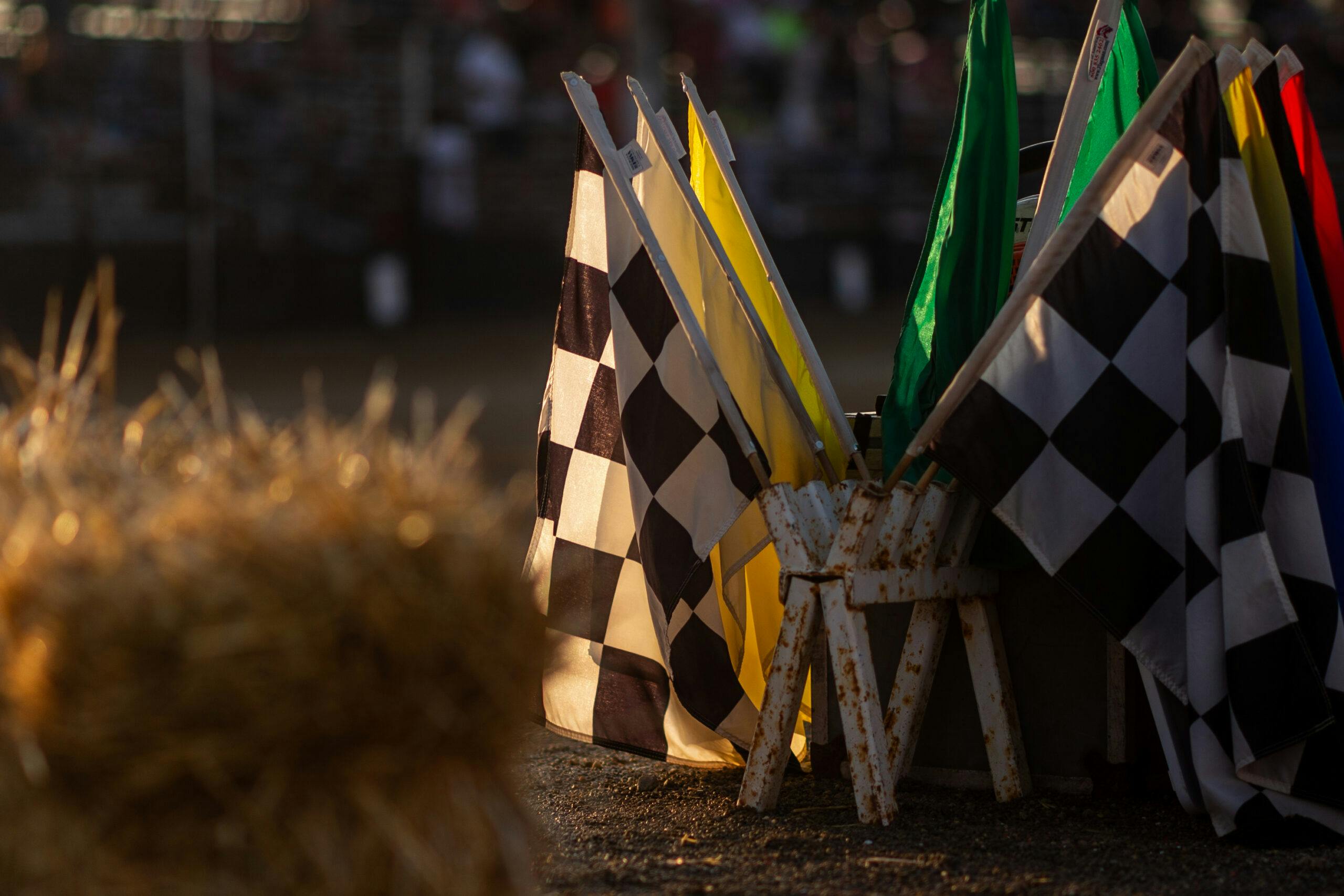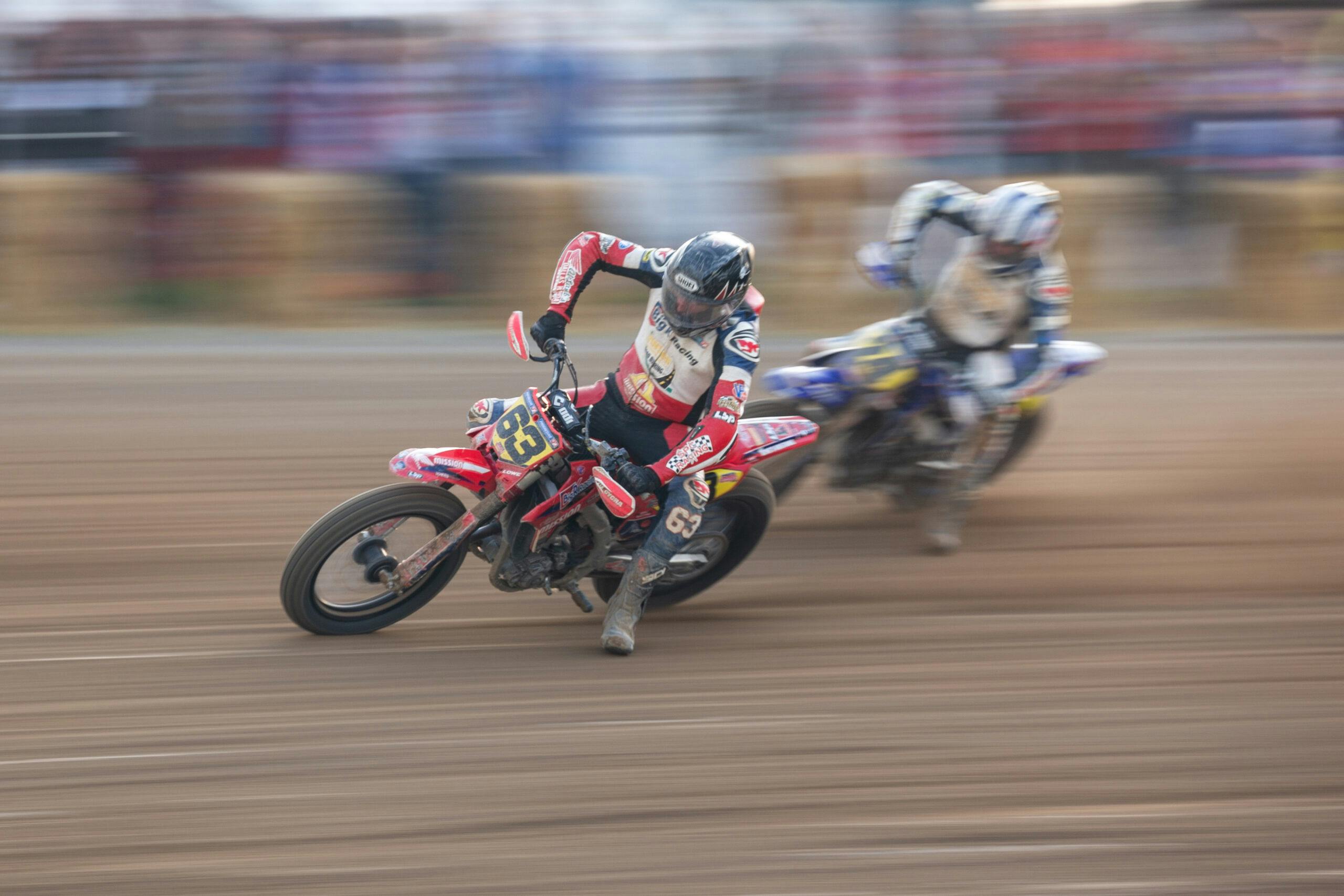Media | Articles
Gallery: Flat-Track Motorcycle Racing Is a Midsummer Night’s Dream
There are 88 counties in Ohio. 86 of them still have fairground racetracks.
This factoid was dispensed over the announcer’s speaker last Saturday, at the Allen County Fairgrounds in Lima, Ohio. Like the majority of the state’s fair venues, Allen County still has its oval track, a flat half-mile covered in pea gravel. The 125-acre parcel of land lies one mile east of I-75 and has hosted the county’s fair since 1950. Like the schedule of any good showground, the summer months bustle with concerts, swap meets, animal exhibitions, and of course motorsports.
I was on hand for the last event. American Flat Track motorcycle racing was in town, and with a rare vacant Saturday night on my calendar, I decided to make the two-hour drive down from Detroit. Once the rain cleared, it was a picture-perfect evening filled with live music, deep-fried fair food, and fast bikes.


I’ve been aware of flat-track motorcycle racing since I can remember, but I’ve never witnessed it in person. These purpose-built bikes race on many of the tracks that I visit while chasing sprint cars and other dirt disciplines. Cool bikes, athletic riders, flying dirt—that’s all I really knew about flat-track.

Until I walked up the side of the half-mile, I didn’t even know the course was covered in pea gravel. Compared to a typical clay surface, gravel provides more comfortable footing for horses and better drainage. Auto racing was recently halted at Indianapolis’ prized mile oval because the course was covered in the tiny rocks. While pea gravel might not be suitable for full-size cars, it works well for bikes, providing you’re not in the wake of a rear tire.
Marketplace
Buy and sell classics with confidence


The direct spray of round pebbles spit from grooved motorcycle tires is like a shotgun blast. “The gravel has blown the zippers off riders’ jackets,” asserts a spectator next to the left of me. Like most of the fans, he and his buddy are up on the fence already. “Back in the day,” he says, “You would lose your spot if you weren’t here.” He motions to the perimeter of chain link surrounding the track. In front of the fence, giant blow-up blocks— with valve stems large enough to fit the nozzle of a leaf blower—protect the riders from the metal fence and prevent them from ending up in spectators’ laps.


At some point, I venture back to my truck to get my camera gear. My parking lot neighbors have pitched an easy-up tent and are bench racing from camping chairs. Betting, too. One of the neighbors, Jerry, approaches and asks if I’d like to join the pool. Like the two dudes I met trackside, Jerry has been coming here for decades. Judging by the parking lot filled with road-going bikes, and a campground that could rival any KOA, the Lima event is an annual pilgrimage.
“It’s only $2 and you just pick a name,” she said while jostling a hat filled with paper scraps. I picked Brandon Robinson, #44.

“Is that good?” I asked.
“That’s who I wanted,” replies one of the neighbors.
Camera gear in hand, I walked to the paddock. The biggest takeaway from the pits: Just like grassroots car racing, the disparity in funding between teams is huge. Rather than open trailers, though, the amateur outfits opt for vans and U-Haul-sized trucks. A couple big-budget teams use 18-wheelers.


Out on the track, they all look the same to the untrained eye:
The rider goes flat out on the straight and then lays the bike down entering the corner. The rear tire slides out toward the fence, while thee rider’s left leg drops down like a kickstand or an outrigger. As they exit the corner, bike and rider gradually stand back up as they enter the straight. Rinse, repeat.


Two classes were on the track that night. AFT Singles is like a feeder series, featuring bikes powered by single-cylinder engines displacing 450cc. These cycles look more like their motocross cousins, while the AFT SuperTwins look like a prototypical flat-track bike with no front fender, and a honkin’ two-cylinder engines (displacement racing from 649cc to 900cc) between the rider’s legs.
The night starts with practice sessions, then qualifying, then heats, then a dash for extra cash among the top runners, then the feature. My guy got third overall. Oh, well, I’m sure I’ll have a chance to play again next year—I can easily see this becoming one of my summer staples.

I had my personal Canon 1DX Mk1 on my shoulder for the entirety of the event. For some of the tight trackside stuff, I was even able to make use of my 400 f/2.8 telephoto lens. (I typically only break that out for road racing coverage.) Swipe to check out some of my favorite shots.
***
Check out the Hagerty Media homepage so you don’t miss a single story, or better yet, bookmark it. To get our best stories delivered right to your inbox, subscribe to our newsletters.












































































Like going to see minor league/ triple ‘A ‘ ball on the weekend. No need to go on line, check. prepare, make sure that, blah blah blah . Easy ,fun , parking is 5 bucks maybe, just walk up to the gate pay a few bucks and you’re in. Very Americana and you’ll still leave with money in your pocket even with spoiling the kids rotten somehow. Stay for the fireworks after. Those Indian FTR 1200 flat trackers are cool bikes too.
I always know that when I see “Cameron Neveu” as the author and/or the photographer, I’m gonna get lost in the photos. Never, never have you disappointed, man!
A fun time for sure and very affordable.
I had an uncle that raced flat track way back in the late Fortys and early fifties at a track way up north. Years later after he stopped racing, he had one of his old bikes leaning against his shop. I was sitting on the thing constantly. I was about thirteen and out of the blue one day he me that I could have it if I could make it run. I got it to turn over, but , that was it. Looking back at my youth it’s probably a good thing.
Man! Thanks so much for the article and the photos.
A couple of years ago I was at Mid-Ohio for Vintage Motorcycle Days. I headed up to Ashland on a perfect Saturday evening for the flat track.
As mentioned above, it was a slice of Americana. Saturday night at an Ohio Fairgrounds. I’ve always loved races that turn left on dirt. Sprinters or flat track motorcycles. These are disciplines that go back to the pre-war (WWII) years.
What struck me most was that as I toured the pits and inspected everything from handshift Harleys and Indians to the newer Royal Enfields (Ride, Build, Train) with women riders working on their own bikes, everybody wanted to engage; why was I so interested, and then they talked about their own journey and background. It was fascinating.
A night to remember in the midst of all of the activity at VMD weekend.
Harley owned flat tracking but I didnt see any in Cameron’s shots. Has that changed? Nice story. Could have talked about the roar and scream of all the bike engines as thats half the excitement. These guys are guts personified!
John- You can catch AFT ( American Flat Track ) on Fox sports regularly. Yes the Harleys did own flat track racing for forever but in that class the Indian now seems to be the class of the field . Indian and Harley still do duke it out in the Bagger Series , although it is kinda of a…weird ? Speaking of true classics the Harley XR -750 flat tracker deserves honorable mention. (Hint Hagerty ) I once wondered if it would be possible to.. somehow maybe plate one…shall we say. Part of one of my favorite text messages …”You know all rebel like. And then there’s the cops looking for the Sunday morning blue plate special. They can’t catch me..nobody can.”
Grew up in Northern California in the 70s. Flat tracking was the thing. Motocross was catching on… Watched Kenny Roberts, Alex Jorgenson running at San Jose, Sacramento, Lodi… Whilst on a business trip to Ohio in the 90s got to watch the flat trackers at Eldora. Now THAT was a experience I’ll never forget. Got to say Hi to Earl Baltes sitting in his spot in the grandstands.
Hello Cameron,
I hope this message finds you. I’m hoping to discuss with you using several of your C8 ZR1 photos in a book I’m years into writing. KS